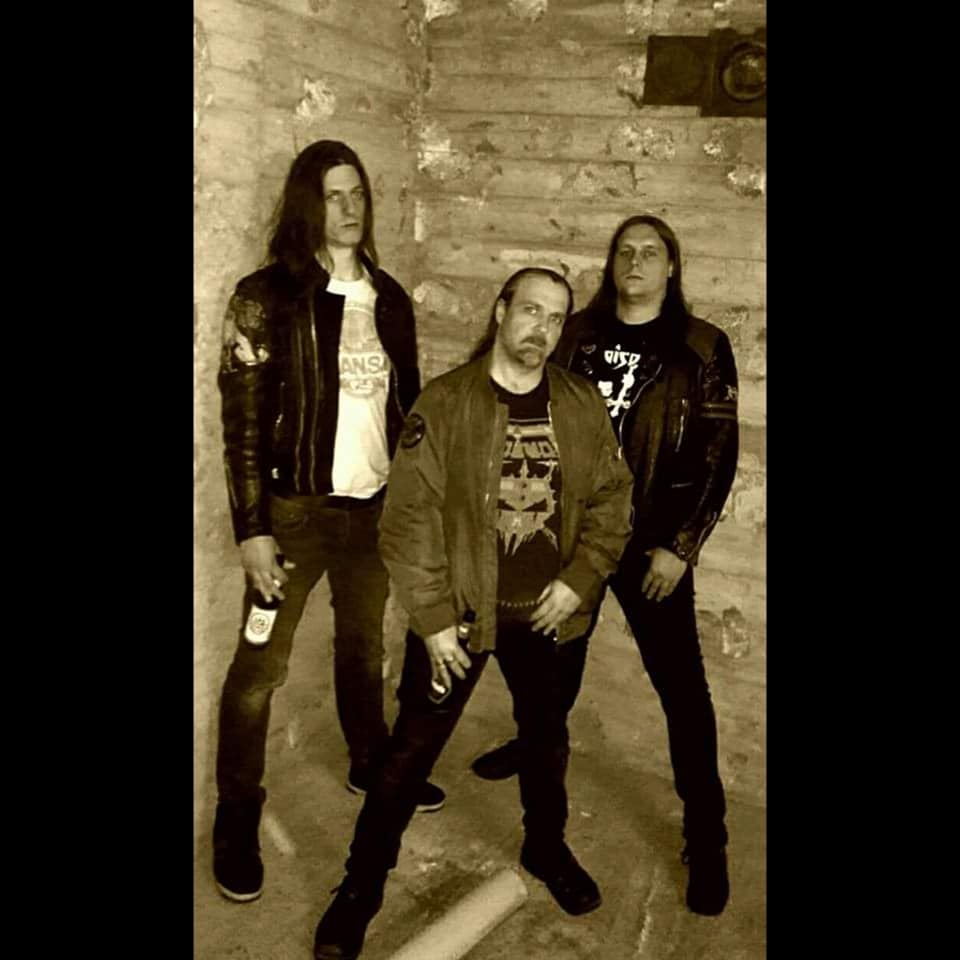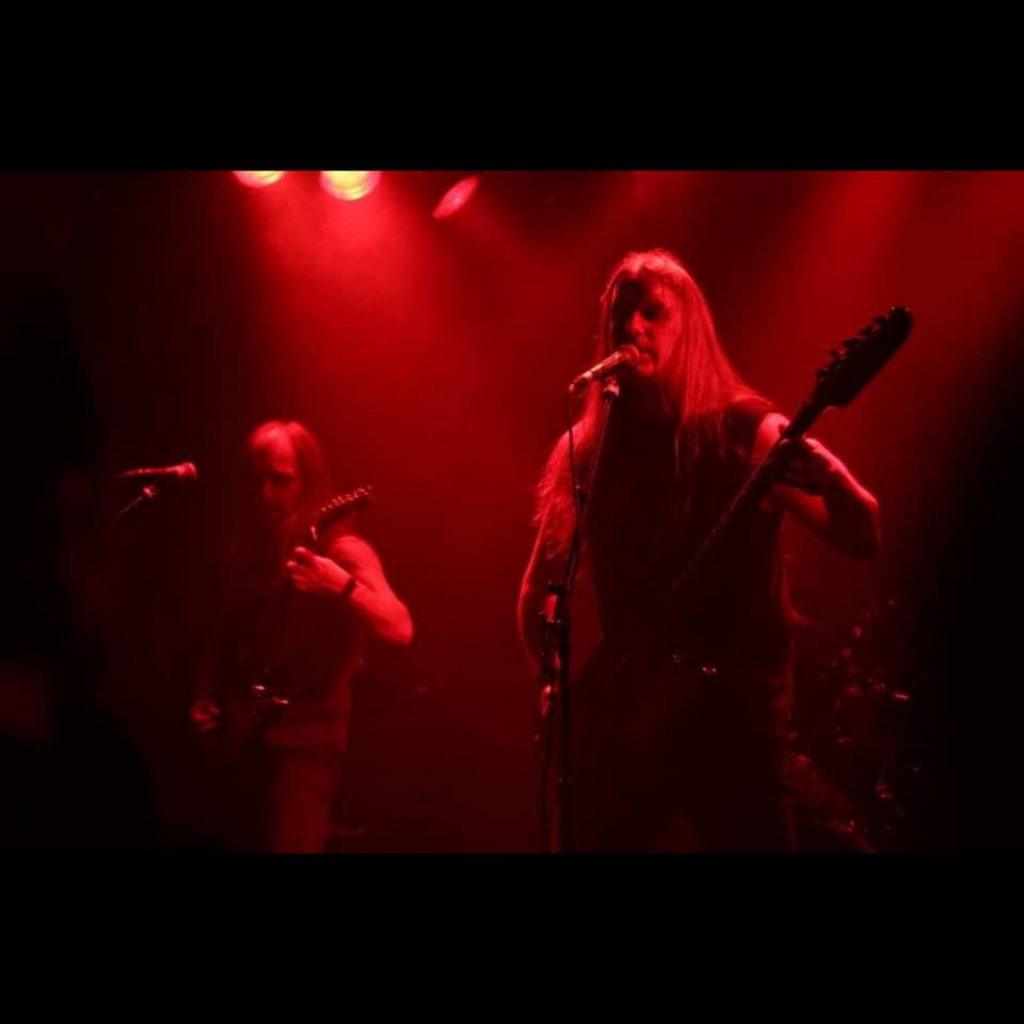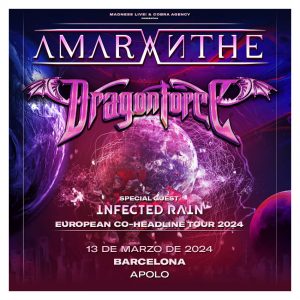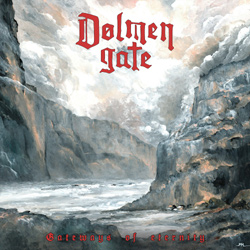KHTHONIIK CERVIIKS (EN)
– Hello, thanks for taking your time, hope you are all healthy over there. Has the whole pandemic situation affected the band’s activity in any way?
Okkhulus Siirs: It didn’t really affect our activities as a band that much. Since we rent a rehearsal room together, which is a private space so to say, we are obviously allowed to be inside of it any given time. Our only concert in 2020 has been scheduled for December even before the pandemia started, so there was nothing in between that would have to be cancelled.
-KHTHONIIK CERVIIKS emerged from the ashes of two bands that split up almost at the same time. From what needs or cravings was the band born?
Okkhulus Siirs: It just felt right to create this new entity. We had been rehearsal room neighbors for a while and when both our bands split up we decided to get in touch with Khraâl Vri*ïl to invite him over to our place. He brought some cool riffs and our first song was born very quickly. We simply wanted to form a new band and continue together what we all loved to do with our former bands.Be loud and spread some chaos.
– That was in 2013, a few demos and here we are, summer 2020, about to release your second album, “Æquiizoiikum”. What significance does it hold to you? I guess a debut full-length might be more like a learning experience, an experiment from which you get to know what methodology works better for you and what works better for the band.
Okkhulus Siirs: We haven’t changed the ways we write our music or approach our rehearsals since the demo days, and “Æquiizoiikum” was recorded in the same studio as our debut album and our split LP with Howls of Ebb. So basically, we tried to keep everything the same on our side and it did work well, I think. The methodology has been the same since the demos: One room, three guys, amps, drumkit, live recording. Vocals and additional guitars overdubbed. It’s the best approach for us since we’re quickly done this way and the recordings sound quite human.
– And to what extent this process/experience is linked to a personal process? As you may know yourselves and each other better now.
Okkhulus Siirs: Speaking only for myself, I think I became naturally able to approach our second and third studio sessions in a more relaxed mood. Apart from that, as a trio we were gladly always able to just play and play and play. Went into the recording room, played for three hours, went back into the control room, listened back and decided which songs to keep and which ones to play again. Everything was clear and transparent to everyone due to our weekly rehearsals. In the studio we just had to nail it a couple of times together. Pure fun.

– Anyway, how would you compare your two records? Is evolution in the band a constant process?
Okkhulus Siirs: “Æquiizoiikum” is probably a tiny bit more Hi-Fi sounding than “SeroLogiikal Scars”, since the studio has changed their workflow a bit meanwhile. It’s still raw and heavy at the core but to me it slightly shines more in the top end. They further professionalized in various fields of technology and I think you can hear it somehow. It is probably a bit more punchy and in-your-face sounding while its compositional structures are a tad less warped and feverish at the same time.
– I read some of the lyrics on the album are based on some research you did on Cotard’s syndrome. One personality well-known for anyone reading this interview that suffered from this syndrome was Dead. What did you find fascinating about this that you decided it to use it for some of the lyrics?
KhraâlVri*ïl: I‘ve been in close contact for over a decade to someone whose mental and somatic shape could be fairly compared with this unpredictable disorder. So myself was thrown into some kind of vertigo consisting of fascination, rejection and deep sadness. By the way, I quit contact to her last year… It‘s nearly impossible to say if the walking corpse itself was to blame for her decay, or just a strong mixture of many aspects. I think the same goes for Per-Yngwe „Dead“ Ohlin. Maybe our Songs are some kind of processing for me on the one hand, but also pure food for the Cerviiks on the other.
Okkhulus Siirs: Cotard’s syndrome is fascinating to me because it seems so abstract and so unthinkable. It reverses and defies any logic on an internal level and violently shuts the doors to any external level. It is an interesting inspiration for all sorts of metaphors.
– To what extent can this be a metaphor about our current society? Is there some criticism?
KhraâlVri*ïl:Yes of course.It‘s obvious that every development has to face its own ending,especially when this so-called progress isn‘t really progress at all.The more this cycle is heading towards disintegration, the more it becomes a devolution.
Just take a look at the current situation for example – always easy to find a fitting scapegoat isn‘t it?Although the origin of the demise lies centuries ago…Don‘t get me wrong, I‘m not against any form of progress in general,but if this really unnatural decadence is the threatening result, then it‘s worth to criticize the status quo.
– “SeroLogiikal Scars” had lyrics dealing with serological scars, so it feels like you are keeping some consistency with biological/scientific-inspired lyrics. Is it something you strive for, to have this cohesion? Even though these are pretty morbid and unsettling themes, they aren’t the usual lyrics we find in extreme Metal.

Okkhulus Siirs: We generally like to base our lyrics on subjects and ideas that somehow cross our paths in everyday life. We try to elaborate on things that we find interesting and try to express our feelings tow them. We usually consult some scientific texts as well as literature and somehow try to formulate metaphors and images that are often also based on mythological or philosophical concepts. Yes, we strive for some cohesion in these regards. We feel that it’s better for ourselves to work and think through certain topics instead of just scribbling down the same rhymes we all have heard dozens of times already.
– Without being a concept opus there are some main, recurring ideas on the album. Which are they? You’ve always had this kind of dystopian vibe, which with the whole current situation going on in the world feels more relatable than ever.
Okkhulus Siirs: Our new album is centered around the image of a futuristic era that is marked by a merciless equalization and depersonalization. Some songs’ lyrics are based on concepts of the death of individual spirit and logic, as noted above. Other songs deal with leadership in that particular dystopian age, the role of the blind followers and their probably impossible katharsis, while the first song generally introduces the listener to the setting where pastime dystopias appear to have become reality.
– With this you manage to convey a post-apocalyptic atmosphere. Is there a specifical image you want to paint with your body of work?
Okkhulus: I think we are exposed to and fed with a strange, superficial and glossy optimism day by day. Although everyone is complaining and falling on everybody elses’ nerves, they are doing so only between garden work and prime time. On TV even death is well-lit and shiny. This burning vehicle is racing downhill without brakes. It’s about time we paint some darker images in general to keep some balance.
– The band’s name (visually too) fits this as well. Can you remember how did you come up with it and what did you want it to transmit?
Okkhulus Siirs: Khraâl Vri*ïl came up with the name and the logo a couple of weeks after we had founded the band. It depicts the style of the band on all levels I think – literally, it combines a mystical or mythological sphere with a biological or scientific one. From the phonological perspective it appears rather awkward and a bit bulky while visuallyit’s somewhat fragile and thin at the same time,but also dangerous and fucked-up since it is quite pointy. The name and logo maybe unite some contradictions, just as our music and lyrics do. These, at first glance, contradictory aspects instantly melt into something integral or cohesive.
– So somehow, even if your albums aren’t conceptual, to some extent the band has a concept. Which is it?
Okkhulus Siirs: As stated before, we like to draw up metaphors and images based on topics we find interesting. We often use rhetoric vehicles from the realm of mythology and try to project them on a scientific tenor, or vice versa. During the run of a record, we are keen on having these images reoccur or we develop and modify their essence further throughout several songs. We also try to incorporate different views on reoccuring guiding themes, thus sometimes creating intertextuality and dialogue across an album. I think our way of writing songs and lyrics does to some degree incorporate thoughts on what is to follow afterwards.
– It’s obvious you are creative and dare to experiment with language. What is language for you? A tool?

Okkhulus Siirs: I generally agree with the Pragmatic viewpoint. Language is always an action in the first place. The purpose behind each action is flexible within context and setting. A tool would just be a prefabricated device with certain ways of intended use prescribed to it. Language however may exceed all this prefabrication. Maybe we are the tools of language.
KhraâlVri*ïl:Language is nothing and everything.Actually just empty shells filled with sounds and meanings and visualization in its written aspect.For sure all those single letters are tools when you‘re hellbent for portmanteau.To me it feels kind of normal to dissect words and amalgamate them to the next stage,just like an automatized process. But sometimes I catch myself doing this and it feels a bit strange,maybe that‘s how everyone feels when he gets caught.
– Playing around with language you break rules. Does this, questioning and breaking with conventionalisms, apply to other aspects of the band?
Okkhulus Siirs: It was sort of an unexpressed agenda of ours from the beginning on to not adhere to certain genre specific rules nor to let measurements placed against our music from the outside have any influence on what we do. We try to incorporate whatever comes to mind, so maybe this sometimes leads to unconventional structures and sounds.
– In poetry and literature in general language is a moldable thing. Are you inspired by literature? Is playing around with words also a visual resource in your music?
Okhhulus Siirs: Yes and yes. We like to not only re-construct ideas on the semantic level but also in terms of phonetic and/or orthographic manipulation. Sometimes we intentionally depict words in a way that they ‘look’ all estranged yet without actually changing their pronounciation, if that makes sense. We also like to create new words or compounds.
– This being said; what does inspire you?
Okkhulus Siirs: In my case, it is mostly Modernist and Post-Modernist literature. Ball, Benn, Valentin, Pound,Huxley, Deleuze & Guattari, Thompson, for instance. All viewed in the light of the burning World 3.0.
-Before we wrap this interview up; how would you describe your new release in just 3 words?
Okkhulus Siirs: Fear and Loathing.
KhraâlVri*ïl: Psychotiik Death Metal…
– And what are the plans for the band now?
Okkhulus Siirs: Between the recording and the release of “Æquiizoiikum”we went separate ways with our drummer and founding member Ohourobohortiik Ssphäross. We meanwhile introduced Gharmonboziia as our new drummer. Together with him we are just practicing a live set featuring songs from all our four official records. I hope we’ll be able to play some shows and start writing new material together in 2021.
– That’s all from our side, thank you once more for answering our interview. If you’d like to add some final words; feel free to do it.
Okkhulus Siirs: We thank for your interest. Keep it Fast and Loud.






